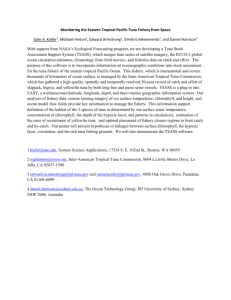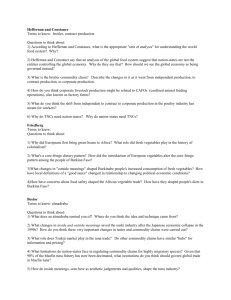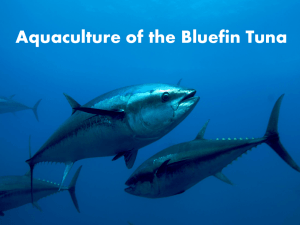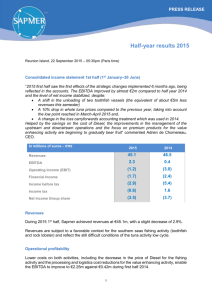isc/06/plenary/11
advertisement
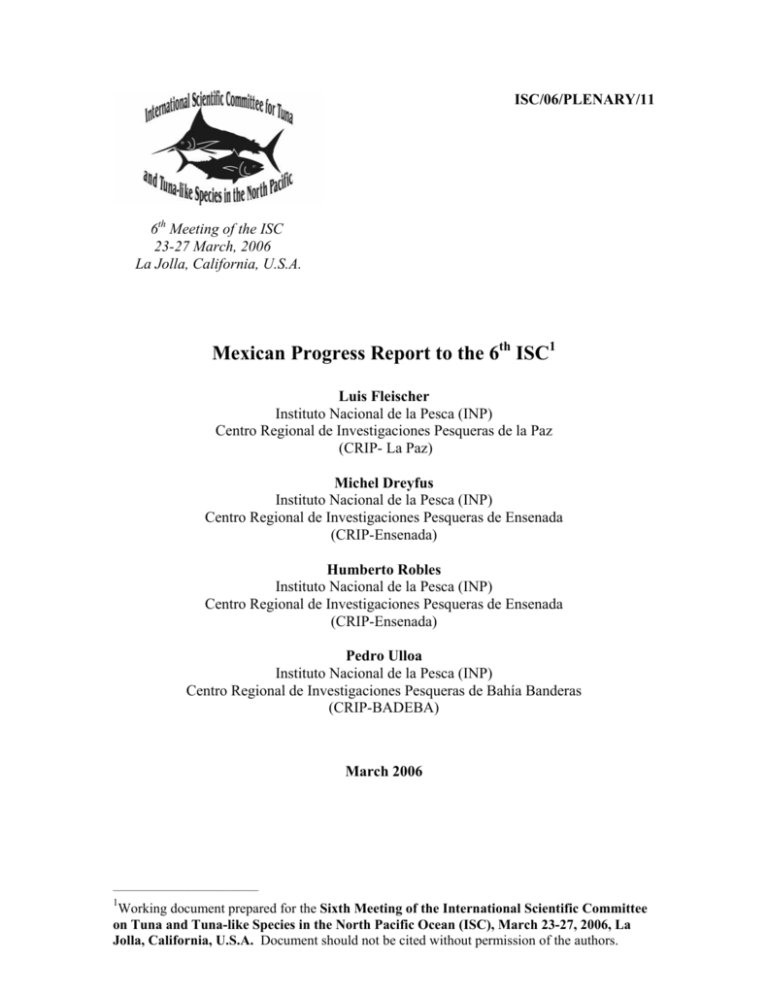
ISC/06/PLENARY/11 6th Meeting of the ISC 23-27 March, 2006 La Jolla, California, U.S.A. Mexican Progress Report to the 6th ISC1 Luis Fleischer Instituto Nacional de la Pesca (INP) Centro Regional de Investigaciones Pesqueras de la Paz (CRIP- La Paz) Michel Dreyfus Instituto Nacional de la Pesca (INP) Centro Regional de Investigaciones Pesqueras de Ensenada (CRIP-Ensenada) Humberto Robles Instituto Nacional de la Pesca (INP) Centro Regional de Investigaciones Pesqueras de Ensenada (CRIP-Ensenada) Pedro Ulloa Instituto Nacional de la Pesca (INP) Centro Regional de Investigaciones Pesqueras de Bahía Banderas (CRIP-BADEBA) March 2006 _____________________________ 1 Working document prepared for the Sixth Meeting of the International Scientific Committee on Tuna and Tuna-like Species in the North Pacific Ocean (ISC), March 23-27, 2006, La Jolla, California, U.S.A. Document should not be cited without permission of the authors. INTRODUCTION: Mexico joined the ISC formally at its 4TH annual reunion in Honolulu, Hawaii, U.S.A. That year, it also attended for the first time the meeting of the Albacore Working Group, which was held in Nanaimo, B.C. For the first time, during these two meetings it reported directly the information related with its fisheries activities with some of the North Pacific highly migratory species (HMS) to the ISC. Before, the Mexican fishery statistics were only reported regionally by the Inter American Tropical Tuna Commission (IATTC), an international fisheries management body to which Mexico cooperates fully. As a new member of the ISC, Mexico was present again in the 5TH annual meeting hosted by the government of Japan in Tokyo. During this year its extended its participation to other Working groups and species related with the ISC, such as the blue fin tuna, the swordfish and the stripped marlins. Its annual report included also then titles of the research projects developed with these resources in its ZEE. Now, in 2006, it is very honored to be present at the 6th annual reunion, this time in la Jolla, California, U.S.A. This national progress report describes the recent trends of the Mexican tuna fishery for the bluefin and albacore tuna and also for the swordfish (Xiphias gladius) as well as, the yellowfin tuna. In this new report, the fisheries statistics previously presented for these species at the 4th and 5TH ISC (Ulloa, Fleischer, Dreyfus and Vaca, 2004 and Dreyfus, Fleischer, Robles and Ulloa, 2005) are expanded. In Mexico, the National Institute of Fisheries (Instituto Nacional de la Pesca, INP), was created more that forty years ago to systematically conducted scientific work and fisheries research with the marine resources of Mexico. The INP is responsible for giving management advice to the fisheries authorities and poses along its coastal states, in both, Pacific and Gulf O Mexico, 14 regional fisheries centers (CRIPS) which are the laboratories uncharged with the recognition, data collecting, sampling and monitoring of the main fisheries and aquaculture activities on a regional scale. Since 1992, the INP incorporated to this effort, the work of the National Tuna-Dolphin Program (Programa Nacional de Aprovechaminto del Atún y Protección del Delfín, PNAAPD), which closely monitored and study the tuna fishery of its purse seine and longline national fleets. The data here reported is based on the combined efforts from these different and unified groups. FISHERIES AND CATCHES Yellowfin Tuna (Thunnus albacares): Catch and the tuna fishery performance of the Mexican fleet had been closely monitored with 100% coverage by scientific observers aboard all the Mexican tuna ships. From this monitoring program, 50% are observers from the Mexican National Program (PNAAPD) and the remaining vessels are covered by the IATTC international observers program. Pertinent data from the two observers programs has been available on a regular base to the ISC and other regional fisheries meetings. There is also a national administrative 1 regulation (Norma Oficial Mexicana-EM-002-PESC-1999) which regulates in Mexico the yellowfin fisheries operations and establishes management regulations for the national fleet. These regulations are determined with the scientific recommendations set by the IATTC. The Mexican tuna purse seine fishery has been the largest in the (ETP) since the mid 1980’s. The fleet concentrates mainly in the yellowfin (Thunnus albacares), which is the prime target tuna species and represents one of the largest within the entire country. This tropical tuna represents for its large volumes the main component in the total catches. The total tuna catch in the ETP of Mexico in 2003 was 181,682 mt. Value which represents the highest historic record for this fishery since the beginning of the Mexican fishery more than forty years ago. Comparatively, the lowest recorded capture in this fishery during recent years was in 1993, with only 115,768 mt., value which is closer to that obtained in 1993. Similarly in 2004 the total catch was 125,335 mt. and in 2005, the reported total catch was of 150,871. In Table I total landings as well as number of active vessels and carrying capacity for 1992 to 2005 is presented. Other tuna species which are also caught, but contrastingly in lower proportions are: the skipjack, (Katsuwonus pelamis), the bigeye (Thunnus obesus), the black skipjack (Euthynnus lineatus) and more recently, in northerly zones of the Mexican EEZ, the bluefin (Thunnus orientalis) and the albacore (Thunnus alalunga). Species composition of the catch is dominated by yellowfin tuna, which has been traditionally the target of the fishery. In the period 2000 to 2005, 69% to 92% and from 89,239 to 164,762 mt. of the catch is yellowfin tuna. Second in importance in terms of volume is skipjack, from 4% to 25% and from 7,206 to 38,949 mt. The other tuna species together represented only between 1% to 7% and from 894 to 9,235 mt. (Table 2). This table also summarizes the total catch of all tunas by the Mexican fleet, by year and by species composition, from 2000-2005. This tabled information reflects again the great importance of the yellowtfin tuna in the Mexican catches and the secondary level of importance all the other tuna species in the total catches obtained by this fleet in the ETP. These high consistent reported catches (particularly 2002 and 2003) are the result of the combination of the fishing experience and performance of the fleet as well as the effect of high recruitments in previous years and are not related with any significant increase in the fishing effort or a greater expansion of its carrying capacity during the corresponding years. Fishing operations of the Mexican purse seine fishery comprise a vast area in the EPO, (figure 1). The recorded levels of tuna captures in the ETP zone by the Mexican fleet from 1992 till 2005 are shown in figure 2. This information has been reported on a regular base to the regional fisheries bodies, such as the IATTC and in the Northern Pacific region directly to the (ISC). 2 Being the largest in numbers, the Mexican tuna fleet is not diverse in terms of fishing gear, mobility, scale operation and species targeting. It consists only of two main fisheries. These includes: a greater component of purse seiners which is the largest and a comparative small portion of bait boats vessels. The purse seiner fleet is subdivided for management and conservation purposes in three different categories: type I, those boats larger than 1000 metric tons, and representing 40% of the total fleet. Type II corresponds to medium to small size ships, more than 363 mt., but less than 1000 mt. with a 22 % of the total and finally, the type III category, in which the small size seiners, less than 363 mt. are grouped and which represents also 20%. The second tuna fishery existing is composed by bait boats, from which in the period reported in here, from 1992-2005, averaged 6 (10%) as active fishing ships. Of this category, in 2004 and 2005, only 2 bait boats were reported active. It can be observed that effort in numbers of vessels and carrying capacity has remained constant. The average carrying capacity of the Mexican fleet from 1992-2005 has been 41,835 mt. Bluefin tuna (T. orientalis): All the fishing zones for bluefin tuna used by the Mexican fleet are located in the Northwest side of the Baja California peninsula, inside the ZEE of Mexico, closer to the ranching locations. The fishing season usually runs five months, from May to September, which is the time in which the transpacific migration of this stock is closer to the Mexican Pacific coast, due to the sea conditions and colder currents. This sea conditions together with the presence of the species, permits the development of this new fishery in the Mexican Northwestern coastal area (Figure 3). The time series of bluefin tuna captured by the Mexican tuna boats from 1995-2005 is presented respectively in Table 3 and figure 4. These catches represent only a very small proportion of the total tuna caught by the Mexican fleet with an average catch of 413 mt. for the entire period. This represents a small proportion of the catch, although very valuable. The 3, 700 mt. reported in 1996 was the first historic highest record for this fishery and the first year bluefin tuna has been targeted by the fleet. Again, in 2004, a total of 8,548 mt. established a higher new catch record for this tuna species in Mexico. The information provided makes clear that fishing for bluefin has not being a foremost significant activity in Mexico for many years. It also shows that even in some fishing seasons there were no captures on this stock, or those were only of low levels. In general, it is observed that in some years, the presence of bluefin tuna landings was small, or even zero. Therefore, it is clear that fishing bluefin in Mexico was considered only incidental. However, more recently, in the years (1996-2005) there has been a greater interest devoted to this species, mainly for the ranching activities developed since1996 in the Northwest region of Mexico. The catch of young bluefin for ranching are performed only with commercial purse seiners (the same vessels that target yellowfin tuna). Some times, the holding nets with the bluefin tunas are transferred to tugboats, which then, make slowly the trip to the 3 enclosures and fattening nets located in the Baja California peninsula, while the tuna purse seiner is fishing again. Ranching Activities: This new tuna fishery component or modality has been the trigger of higher proportional catches of bluefin. In 2005, the catch came down to 4545, again making evident that oceanographic conditions and the eastern distribution of the specie are limiting factors for the Mexican bluefin fishery. Most of the catch is utilized for fattening. In 2004, 80% was utilized for the ranching companies and the other 20% went for Mexican consumption in 2004. Data from 2005 is being processed. This new activity represents a new economic incentive for the Mexican tuna fishery. For conservation and monitoring purposes, a set limiting the ranching process was imposed by the Mexican government only in the two of the existing five companies, up to 120 mt. per year. The Mexican progress report 2005, (Dreyfus, Michel and Ulloa, 2004) synthesizes the history the ranching activities for bluefin tuna started in Mexico since its beginning in 1997. Research has been focused on yellowfin tuna but recently also research on several aspects of bluefin fishery are on there way, for example modeling and predicting bluefin tuna recruitment. Albacora (T. alalunga): The related Mexican information for this fishery has been consecutively reported to ISC, the IATTC and to the Eighteen (Hawaii) meeting, to the Nineteen (Nanaimo) meeting. More recently to North Pacific Albacore Workshop hosted in Japan. To the first, the catch for Mexico was tabled by the IATTC (M. Hinton, pers. com), for the period 1961 through 2002. For the second meeting identified, Fleischer, Dreyfus and Robles (2004) revised, corrected and expanded the data, with the 2003 available information. Here these records are enlarged with the 2004 and 2005 information, (Table 4). The data indicates that the fishery for albacore is performed in Mexico only optionally, or incidentally, as a non target species. Consequently, no reliable data is available for the effort. This is, however, an important aspect which will be considered by the INPPNAAPD to be monitored in the upcoming seasons. The data presented here is considered to be our best estimate of the Mexican historic catches for this North Pacific tuna species. Swordfish (X. gladius): The development of the swordfish fishery in Mexico has two different historical periods. One was started in 1964 using long liners and the second began in 1986, with gillnets. Also, since 1990, all the billfishes (including the swordfish), had been reserved by Mexican law only for sport fisheries operations and they are not subject to any commercial catches in a defined marine zone around the Mexican coast. This regulation 4 designated a strip of fifty miles from the Mexican coast as a reserved zone for these activities. From those species reserved to the sport fisheries, the swordfish is the only commercially captured outside the defined corridor. In 1992 the swordfish fleet was integrated by 24 active fishing boats. In 1995 this fleet reduced its size to 22 ships, number which has not changed since. The main ports used by this fishery are: Ensenada, San Carlos, and some times, la Paz, in the Baja California peninsula and also across the Gulf of California in Mazatlan in the mainland Mexico. The fleet operates mainly in the autumn and winter, fishing some years from five to six months (from September-October to February). Nowadays the Mexican long liner fleet operates between the latitudes 21o 30’N and 32o 20’N. The greater effort is concentrated in two areas from September to January. One is south of Punta Eugenia in the Baja California peninsula to the 23oN and the other fishing zone, from the 30o parallel, to the northern limit of the Mexican ZEE (Castro, et. al. 1995; Sosa et. al. 1992, (Figure 5). The historic records of the swordfish fishery of the Mexican fleet are presented in Table 5 and Figure 6. These indicate three different pick periods: 1981 (1,575 mt.), 1990 (2,650 mt.) and 1998 (3,603 mt.), which is the highest historic record for this fishery. In 2003, the reported catch was 671 mt. The variation is attributed to the changes in the two fishery methods described above. The data from 2004-2005 still is in process. In the case of the swordfish fishery of Baja California, the trend in catches from 1990 to 2005 is shown in figure 7. In accordance with (FAO, 2000) the total world captures of swordfish are about 90,000 mt. each year. From those, 25, 000 mt. are taken from the Pacific Ocean and the Mexican fleet contributes to those with an average of 950 mt. each season. This represents only (3.8%) of the total Pacific Ocean captures. In the ETP, the swordfish shows a stable CPUE since 1995 (Bartoo and Coan, 1989; Joseph, 1981). FISHERIES MONITORING, DATA COLLECTING AND REPORTING Purse Seine and Live Bait Ship Fisheries: Catch and effort data and the purse seine tuna fishery performance had been closely monitored with a 100% coverage by scientific observers aboard all the large commercial Mexican tuna ships. From these monitoring program, 50% are observers from the Mexican National Program (PNAAPD) and the remaining vessels are covered by the IATTC international observers program. Pertinent data from the two observers programs has been available on a regular bases to the IATTC, ISC and other regional meetings. There is also a national administrative regulation (Norma Oficial Mexicana-EM-002PESC-1999) which regulates in Mexico the yellowfin fisheries operations and establishes a quota for the national fleet. This quota is determinate with the scientific recommendations set by the IATTC in the EPO. Besides this, logbooks are submitted by the fleet to the Fishery agency in Mexico, CONAPESCA (Comisión Nacional de Pesca), 5 Ministry of Agriculture, Live stock and Fisheries). Landings are obtained from each vessel with (100% coverage). Fish are measured for fork length by PNAAPD observers on board. The IATTC Secretariat in close coordination with the INP-PNAAD continues to compile the data and related effort, catch and statistics from all the Mexican tuna fleet operations and the PNAAPD covers those vessels which are not monitored by the IATTC. Swordfish fishery The swordfish fishery was also monitored since 1998 till 2000 by the observers of PNAAPD, aboard the longliners and the gillnet ships which operated outside the 50 miles defined zone. Also logbooks are submitted by the fleet to the Fishery agency in Mexico CONAPESCA This fishery is also regulated by a special Mexican administrative regulation (NOM-017-PESC-1994). RESEARCH Since 1998 the INP and the PNAAPD have also organized an annual scientific meeting in Mexico to review the research activities developed by Mexican and other scientists. These studies are related with tunas, large pelagic and other oceanic species. Available information of those seven scientific meetings could be obtained directly from the authors listed, or from the INP-PNAAPD sources. Here we summarize the original titles (in Spanish) of the most recent papers presented on the VIII National Forum celebrated at Mazatlan, Sinaloa, Mexico from the 24 to 25 of November 2005: • CAPTURA DE TÚNIDOS POR TIPO DE LANCES EN EL OPO POR LA FLOTA CERQUERA MEXICANA (1992-2004) Marina Eva Hernández González y Héctor Pérez, PNAAPD • VARIABILIDAD ESPACIO-TEMPORAL DE LAS CAPTURAS DE ATÚN ALETA AMARILLA EN AGUAS ADYACENTES A LAS ISLAS MARÍAS, MÉXICO Dámaris López Medina y Sofía Ortega García, CICIMAR-IPN • INFLUENCIA DE VARIABLES AMBIENTALES EN LAS CAPTURAS DE ATÚN ALETA AMARILLA EN LA ZONA DE LAS ISLAS REVILLAGIGEDO, MÉXICO Juan Pedro Arias Aréchiga y Sofía Ortega García CICIMAR-IPN • LA PESQUERÍA DE ATÚN ALETA AZUL EN EL PACÍFICO Y UN MODELO DE PREDICCIÓN DEL RECLUTAMIENTO. Michel Jules Dreyfus León INP-PNAPD • HÁBITOS ALIMENTICIOS DEL ATÚN ALETA AMARILLA Thunnus albacares, CAPTURADO EN EL OCÉANO PACÍFICO ORIENTAL Vanessa Guadalupe Alatorre Ramirez y Felipe Galván Magaña CICIMAR - IPN 6 • DISTRIBUCIÓN DE LA CAPTURA DE ATÚN ALETA AZUL POR LA FLOTA ATUNERA CERQUERA MEXICANA CON OBSERVADORES DEL PNAAPD EN EL OPO (1992-2004) Héctor Pérez y Marina Eva Hernández González, PNAAPD • HÁBITOS ALIMENTICIOS DEL ATÚN ALETA AZUL EN LA COSTA OCCIDENTAL DE BAJA CALIFORNIA SUR Sofía Ortega García, Arturo Tripp Valdez, Rubén Rodríguez Sánchez, CICIMAR - IPN • IMPACTO DE EL NIÑO/OSCILACIÓN DEL SUR (ENOS) EN LAS CAPTURAS DE ATUNES EN EL OCÉANO PACÍFICO DEL ESTE Juan Suárez Sánchez, Walter Ritter Ortiz, Carlos Gay García y Jenny Romero Hernández, Universidad Autónoma de Tlaxcala-UNAM. • DIFERENCIAS GENÉTICAS ENTRE POBLACIONES NOR- Y- SURECUATORIALES DE ATÚN ALETA AMARILLA DEL PACÍFICO ORIENTAL Píndaro Díaz Jaimes y Manuel Uribe Alcocer, UNAM • PRESENCIA DE LARVAS DE ATUNES EN LA PARTE SUR DEL GOLFO DE CALIFORNIA Rogelio González Armas, Rene Funes Rodríguez y Emilio Beier, CICIMAR– IPN-CICESE campus en BCS • PESQUERÍA DEL ATÚN EN EL OCÉANO PACÍFICO ORIENTAL: EVALUACIÓN DE ÁREAS PESQUERAS DURANTE 2003 MEDIANTE UN ANÁLISIS ESPACIO-TEMPORAL CONSIDERANDO OBJETIVOS MÚLTIPLES Y DIFERENTES PONDERACIONES Ricardo Carrara Rosales, Juan G. Vaca Rodríguez, Gabriela Montaño M y Eliseo Almanza H. UABC-PNAAPD • CAPTURA INCIDENTAL DE PICUDO EN LA PESQUERÍA CERQUERA MEXICANA DE ATÚN EN EL OCÉANO PACÍFICO ORIENTAL Iván Abiut Leyva García, Juan G. Vaca Rodríguez, Oscar Sosa Nishizaki y Michel Dreyfus León. UABC-PNAAPD-CICESE • DISTRIBUCIÓN ESPACIO TEMPORAL DE LAS CAPTURAS INCIDENTALES DE ELASMOBRANQUIOS EN LAPESQUERÍA MEXICANA DE ATÚN CON REDES DE CERCO EN EL PACÍFICO ORIENTAL Jennyfer Chong Robles, Oscar Sosa Nishizaki y Juan G. Vaca Rodríguez. CICESE-FCM/UABC-PNAAPD 7 • VARIABILIDAD ESPACIO-TEMPORAL DE LAS CAPTURAS INCIDENTALES DE DORADO REALIZADAS POR LA FLOTA ATUNERA EN EL PACÍFICO ORIENTAL Sofía Ortega García, Rubén Rodríguez Sánchez, Juan Guillermo Vaca Rodríguez y Heriberto Santana Hernández. CICIMAR-IPN-INP/CRIP Manzanillo. • EVALUACIÓN DE LA PESCA DE ATÚN CON PALANGRE EN EL GOLFO DE MÉXICO, DURANTE 2004 Karina Ramírez López, Rafael Solana Sansores y Cecilia Quiroga Brahms, INP • CAPTURA INCIDENTAL DE ESPECIES NO OBJETIVO OBTENIDA POR BARCOS PALANGREROS DE MEDIANA ALTURA DEL PUERTO DE MANZANILLO, DIRIGIDOS A LA PESCA DE TIBURÓN, DURANTE EL PERIODO 2003-2005 Heriberto Santana Hernández y Juan Javier Valdez Flores, INP/CRIP – Manzanillo. • CAPTURA INCIDENTAL DE TORTUGAS MARINAS EN PALANGRES DE DERIVA POR LAS EMBARCACIONES DE MEDIANA ALTURA DEL PUERTO DE MANZANILLO, COLIMA: 2003 – 2005 Heriberto Santana Hernández, Juan Javier Valdez Flores y María del Carmen Jiménez Quiroz INP/CRIP – Manzanillo • DISTRIBUCIÓN Y ABUNDANCIA RELATIVA DE LA RAYA DE LÁTIGO Dasyatis violacea, CAPTURADA INCIDENTALMENTE EN EL PACÍFICO CENTRAL MEXICANO Heriberto Santana Hernández, Elaine Espino Barr y Juan Javier Valdez Flores, INP-CRIP – Manzanillo. • TIPO DE CARNADA EN ANZUELOS Y SU INFLUENCIA EN LA CAPTURA DE TIBURONES Y ESPECIES ASOCIADAS Ildefonso Galeana Villaseñor, Jorge Aguilar Rubio, Arturo Ramos Hernández y Gerardo Campos Carrillo ITMAR • DISTRIBUCIÓN ESPACIO-TEMPORAL DE LA CPUE DEL PEZ VELA (Istiophorus platypterus) REGISTRADA POR LOS BARCOS PALANGREROS QUE OPERARON EN EL NOROESTE DE MEXICO DURANTE EL PERIODO 1985-1987 Fernando Arias Olaiz, Sofía Ortega Garcíay Juan Pedro Arias Aréchiga. CICIMAR–IPN • VARIACIÓN ESPACIO-TEMPORAL DE LAS TASAS DE CAPTURA DEL MARLÍN RAYADO (Tetrapturus audax) EN ELNOROESTE DEL PACÍFICO MÉXICANO 8 Shelley Salcedo Bojórquez, Sofía Ortega García, Víctor Manuel Gómez Muñoz y Heriberto Santana Hernández,CICIMAR-IPN-INP/CRIP -Manzanillo • EVALUACIÓN DE TRES ESTRUCTURAS DURAS DEL DORADO Coryphaena hippurus (PICES: CORYPHAENIDAE),PARA LA DETERMINACIÓN DE MARCAS DE CRECIMIENTO Guadalupe Minerva Torres Alfaro, Marcela S. Zúñiga Flores, y Sofía Ortega García CICIMAR-IPN • ANÁLISIS COMPARATIVO DE LOS PARÁMETROS DE CRECIMIENTO DEL DORADO (Coryphaena hippurus)ESTIMADOS EN DOS ÁREAS DEL PACÍFICO CENTRAL ORIENTAL: UNA PROPUESTA DE ESTUDIO Manuel Peralta Bravo, Sofía Ortega García, Francisco Arreguín Sanchez, Rubén Rodríguez Sánchez.CICIMAR-IPN • DISTRIBUCIÓN DE LARVAS DE DORADO Coryphaena hippurus (Linnaeus, 1758) EN EL PACÍFICO ORIENTAL MEXICANO. Norma Alejandra Sánchez Reyes, Rogelio González Armas, y Emilio Beier CICIMAR-IPN-CICESE Unidad La Paz 9 Figure 1. Fishing grounds of the Mexican tuna purse seine fishery 10 tons 200000 180000 160000 140000 120000 100000 80000 60000 40000 20000 0 YFT SKJ BFT TOTAL 1980 1985 1990 1995 2000 2005 Figure 2. Mexican tuna catch of yellowfin tuna (YFT), skipjack (SKJ) and bluefin tuna (BFT), 1980-2005. 11 Table 1. Total landings, size, composition and carrying capacity of the Mexican tuna fleet from 1992-2005. YEAR Total Catch (All tuna species) (mt.) No. of acti ve tuna boat s No. of large PSeiners >1000 mt. No. of m PSeiners >363 mt. <1000 mt. No. of PSeiners <363 mt. No. of active Bait Boats Total Carrying Capacity of the Fleet (mt.) 1992 1993 1994 1995 1996 1997 1998 1999 2000 2001 2002 2003 2004 2005 AVERAGE 127,121 115,768 127, 866 149,189 149,375 154,184 128,514 139,851 118, 362 136,768 160,513 181,682 125,335 150,871 141,273 52 47 54 55 62 63 63 66 64 64 59 62 60 60 59 29 23 24 22 22 27 25 25 25 24 23 24 26 27 24 14 12 14 15 15 14 14 15 14 12 13 15 13 14 13 4 6 11 12 12 12 12 14 16 18 18 19 19 17 13 5 6 5 6 6 10 12 12 9 10 5 4 2 2 6 43,158 37,553 38,670 38,255 37,302 42,836 41,330 41,690 42,035 41,427 41,004 43,601 44,532 46,300 41,835 12 Table 2. Total catch and the proportions of the different tuna species in the Mexican fishery from 2000-2005 YEAR TOTAL catch Yellowfin All tuna species (mt.) and (%) (mt.) 2000 118, 362 2001 136,768 2002 160,513 2003 181,682 2004 125,335 2005 150,871 97,703 (82.54%) 126,096 (92.19%) 151,213 (94.20%) 164,762 (90.68%) 89,239 (71.20%) 105,128 (69.68%) Skipjack (mt.) Other and (%) Species* (mt.) and (%) 16,928 3,731 (14.30%) (3.15%) 9,778 894 (7.14%) (0.65%) 7,206 2,094 (4.48%) (1.30%) 13,479 3,441 (7.41%) (1.89%) 26,861 9,235 (21.43%) (7.36%) 38,949 6,794 (25.81%) (4.50%) * Other species are: albacore (T. alalaunga), bluefin (T. orientalis), bigeye (T. obesus) and the black skipjack (Euthynnus lineatus). 13 Figure 3. Fishing Zones for bluefin tuna in the Northwest region of Mexico, offshore the Baja California peninsula. 1992-2004. (data 2005 not available yet) 14 Table 3. Bluefin tuna catch of Mexico (tons), 1995-2005. 1996 3700 1997 367 1998 1 1999 2369 2000 3025 2001 863 10000 8000 tons 6000 4000 2000 20 05 20 03 20 01 19 99 19 97 0 19 95 MEXICO . 1995 11 Figure 4. Bluefin tuna catch from 1995-2005, Mexican fleet 15 2002 1714 2003 3211 2004 8548 2005 4545 Table 4. Mexican albacore tuna catches (tons) from 1980-2005 YEAR 1980 1981 1982 1983 1984 1985 1986 1987 1988 1989 1990 1991 1992 1993 1994 1995 1996 1997 1998 1999 2000 2001 2002 2003 2004 2005 AVERAGE MEXICAN CATCH 0 10 0 0 179 54 0 0 0 0 0 0 0 0 0 0 0 0 8 23 79 22 28 29 106 0 21 16 CAPTURA POR LANCE 1999 - 2000 1 pez espada ZEEM 30° L A T I T U D N 66 peces espada MÉXICO 25° 20° 120° 115° 110° L O N G I T U D 105° W Figure 5. Swordfish fishing grounds in Mexico and catches by set (data till 2003). 17 Table 5: Historic records of the Mexican swordfish fishery from 1979-2003 ( data from 2004-2005 is in process) YEAR 1979 1980 1981 1982 1983 1984 1985 1986 1987 1988 1989 1990 1991 1992 1993 1994 1995 1996 1997 1998 1999 2000 2001 2002 2003 2004-2005 MEXICAN CATCHES (MT.) 7 380 1, 575 1, 365 120 47 18 422 550 613 690 2, 650 861 1,160 812 581 437 439 2, 365 3, 603 1, 136 2, 216 780 465 671 In process Notes:1) Data sources from INP-CONAPESCA-Mexico 18 captura tm 4000 3000 2000 1000 0 2003 2002 2001 2000 1999 1998 1997 1996 1995 1994 1993 1992 1991 1990 1989 1988 1987 1986 1985 1984 1983 1982 1981 1980 1979 AÑOS Figure 6. Swordfish captures by the Mexican fleet from 1979-2003. ( Data from 2004-2005 in process) 19 1000 tons 800 600 400 200 20 04 20 02 20 00 19 98 19 96 19 94 19 92 19 90 0 Figure 7. Match of swordfish in Baja California, 1990-2005 20
